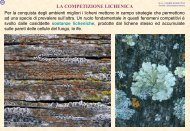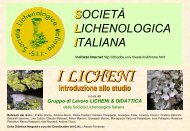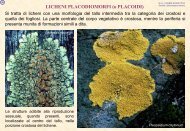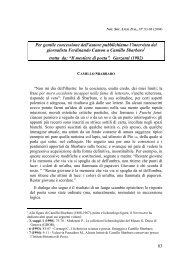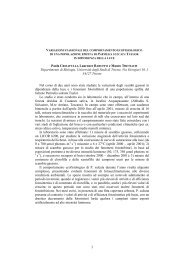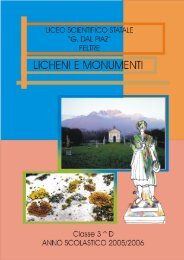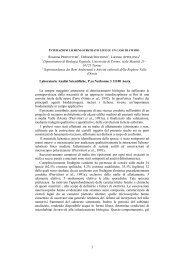KEY to terricolous lichens - italic
KEY to terricolous lichens - italic
KEY to terricolous lichens - italic
Create successful ePaper yourself
Turn your PDF publications into a flip-book with our unique Google optimized e-Paper software.
16<br />
plane, smooth, K+ red. Margin distinct, thin, orange-yellow, K+ red. Epihymenium<br />
K+ red. Ascospores 1-celled, hyaline, ellipsoid, thin-walled, 8 per ascus, 9-13 x 4-7 µ.<br />
Pycnidia orange-yellow, immersed. Conidia bacilliform. Pho<strong>to</strong>biont chlorococcoid.<br />
Ascospores not restricted in the center Thallus thick, little dissected at margin, more<br />
or less pruinose. - Note: on more or less calcareous soil and <strong>terricolous</strong> mosses in open<br />
situations, sometimes in fissures of calcareous rocks, the record of Grillo (1998) from<br />
the coast of Sicily, is certainly due <strong>to</strong> a misidentification.<br />
Squamules plane. Thallus thin, areolae dissected at margin, not or faintly pruinose<br />
Fulgensia bracteata v.alpina<br />
Thallus crus<strong>to</strong>se, orange-yellow, K+ red, C-, P-. Areolae rounded, flattened,<br />
contiguous, adpressed <strong>to</strong> the substratum. Apothecia frequent, lecanorine, sessile.<br />
Surface orange, plane, smooth, K+ red. Margin distinct, thin, orange-yellow, K+ red.<br />
Epihymenium K+ red. Ascospores 1-celled, hyaline, ellipsoid, thin-walled, 8 per<br />
ascus, 9-13 x 4-7 µ. Pycnidia orange-yellow, immersed. Conidia bacilliform.<br />
Pho<strong>to</strong>biont chlorococcoid. Ascospores not restricted in the center Thallus thin, areolae<br />
dissected at margin, not or faintly pruinose. - Note: on soil and over mosses in fissures<br />
of calciferous, mostly schis<strong>to</strong>se rocks, a poorly known taxon, well worthy of further<br />
study, certainly more widespread in the Alps.<br />
17 Pho<strong>to</strong>biont cyanobacterial<br />
Moelleropsis nebulosa<br />
Thallus crus<strong>to</strong>se, pale blue-grey <strong>to</strong> dark blue-black, granulose. Apothecia frequent,<br />
lecanorine, semi-immersed, not constricted, up <strong>to</strong> 1 mm diam. Surface brown. Margin<br />
distinct, granulose. Subhymenium brownish. Paraphyses simple, adglutinated.<br />
Ascospores 1-celled, hyaline, ellipsoid, 8 per ascus, (11)13-15(20) x 6-8 µ. Pho<strong>to</strong>biont<br />
cyanobacterial. Ascospores sometimes attenuated at one end, with a single oil droplet.<br />
- Note: an early colonizer of clay-sandy soil, esp. earth banks along unpaved roads, in<br />
humid areas with siliceous substrata, most frequent in Tyrrhenian Italy, from the<br />
lowlands (in very humid areas) <strong>to</strong> the mountains.<br />
17 Not as above 18<br />
18 Pho<strong>to</strong>biont trentepohlioid 19<br />
18 Pho<strong>to</strong>biont chlorococcoid 23<br />
19 With perithecia 20<br />
19 With apothecia 21<br />
20 Ascospores fusiform, 8 per ascus. Conidia cylindrical<br />
Porina mammillosa<br />
Thallus crus<strong>to</strong>se, green-grey <strong>to</strong> dark grey, often tinged brown-purple, thick,<br />
continuous, K-, C-, KC-, P-. Perithecia frequent, immersed in thalline warts, globose,<br />
half immersed, not flattened, with apical involucrellum, up <strong>to</strong> 0.5 mm diam. Surface<br />
black. Paraphyses simple, not apically thickened, free. Asci cylindrical. Ascospores<br />
hyaline, fusiform, 8 per ascus, 25-40 x 4-6 µ. Pycnidia dark, sessile. Conidia<br />
cylindrical. Pho<strong>to</strong>biont trentepohlioid. - Note: on bryophytes and plant debris.<br />
20 Ascospores oblong-obtuse, more than 32 per ascus. Conidia filiform<br />
Thelopsis melathelia<br />
Thallus crus<strong>to</strong>se, reddish-brown, K-, C-, KC-, P-. Perithecia frequent. Surface black.<br />
Asci cylindrical. Ascospores 4-celled, hyaline, oblong-obtuse, more than 32 per ascus,<br />
11-20 x 4-7 µ. Conidia filiform. Pho<strong>to</strong>biont trentepohlioid. - Note: on muribund<br />
bryophytes, humic soil and plant remains in areas with calcareous, or basic siliceous<br />
rocks.<br />
21 Ascomata sessile<br />
Gyalecta peziza<br />
21<br />
Thallus crus<strong>to</strong>se, whitish, thin, K-, C-, KC-, P-. Apothecia frequent, without a thalline<br />
margin, sessile, strongly constricted, up <strong>to</strong> 3 mm diam. Surface yellowish, concave, K-<br />
, C-, KC-, P-. Margin distinct, thick, whitish, paler than disk, K-, C-, KC-, P-.<br />
Ascospores 4-celled, hyaline, ellipsoid, 8 per ascus, 14-21 x 3-6 µ. Pho<strong>to</strong>biont<br />
trentepohlioid. All septa of the spores parallel. - Note: on slightly calcareous soil rich<br />
in humus, and on <strong>terricolous</strong> bryophytes.<br />
Ascomata immersed<br />
33<br />
22



